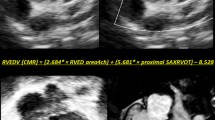Abstract
Residual pulmonary insufficiency in post-repair Tetralogy of Fallot (rToF) patients often mediates biventricular dysfunction which is associated with long-term adverse clinical outcomes. The objective of this study was to demonstrate the presence of impaired left ventricle (LV) circumferential strain (CS) in pediatric rToF patients as compared to controls using cardiac magnetic resonance imaging (CMRI). Additionally, bivariate analysis between right ventricle (RV) and LV functional measures in rToF patients was performed to further characterize the interventricular interactions thought to mediate LV dysfunction secondary to RV volume overload. The medical records of 12 rToF patients (mean age 13.3 years) and 9 controls (mean age 10.9 years) were analyzed. LV global CS was significantly decreased in rToF patients versus controls (p = 0.04). This impairment was differentially distributed within the LV, with only the LV anterior and anterior lateral walls significantly decreased versus controls (p = 0.04, p = 0.03). Bivariate analysis revealed a significant correlation between RV mean CS and LV EF (r = 0.71, p = 0.01), RV infundibulum CS and LV EF (r = 0.70, p = 0.01), RV infundibulum CS and LV anterolateral wall CS (r = 0.59, p = 0.04), and RV infundibulum CS and pulmonary regurgitation fraction (r = −0.63, p = 0.03). These findings support existing research implicating interventricular interactions in the development of LV dysfunction. Furthermore, the segment specific CS impairment in the LV suggests a possible spatial component to these interactions. The success of this study in identifying regional myocardial strain impairment indicates CMRI based techniques may be useful in localizing otherwise undetectable myocardial dysfunction.

Similar content being viewed by others
References
Airan B, Choudhary SK, Kumar HV, Talwar S, Dhareshwar J, Juneja R et al (2006) Total transatrial correction of Tetralogy of Fallot: no outflow patch technique. Ann Thorac Surg 82(4):1316–1321 (discussion 1321)
Alpert JS (2001) The effect of right ventricular dysfunction on left ventricular form and function. Chest 119(6):1632–1633
Apitz C, Webb GD, Redington AN (2009) Tetralogy of Fallot. Lancet 374(9699):1462–1471
Castillo E, Osman NF, Rosen BD, El-Shehaby I, Pan L, Jerosch-Herold M et al (2005) Quantitative assessment of regional myocardial function with MR-tagging in a multi-center study: interobserver and intraobserver agreement of fast strain analysis with harmonic phase (HARP) MRI. J Cardiovasc Magn Reson 7(5):783–791
Cikes M, Sutherland GR, Anderson LJ, Bijnens BH (2010) The role of echocardiographic deformation imaging in hypertrophic myopathies. Nat rev Cardiol 7(7):384–396
el Ibrahim SH (2011) Myocardial tagging by cardiovascular magnetic resonance: evolution of techniques—pulse sequences, analysis algorithms, and applications. J Cardiovasc Magn Reson 13:36
Garot J, Bluemke DA, Osman NF, Rochitte CE, McVeigh ER, Zerhouni EA, Prince JL, Lima JA (2000) Fast determination of regional myocardial strain fields from tagged cardiac images using harmonic phase MRI. Circulation 101(9):981–988
Geva T (2011) Repaired Tetralogy of Fallot: the roles of cardiovascular magnetic resonance in evaluating pathophysiology and for pulmonary valve replacement decision support. J Cardiovasc Magn Reson 13:9
Geva T, Sandweiss BM, Gauvreau K, Lock JE, Powell AJ (2004) Factors associated with impaired clinical status in long-term survivors of Tetralogy of Fallot repair evaluated by magnetic resonance imaging. J Am Coll Cardiol 43(6):1068–1074
Geyer H, Caracciolo G, Abe H, Wilansky S, Carerj S, Gentile F et al (2010) Assessment of myocardial mechanics using speckle tracking echocardiography: fundamentals and clinical applications. J Am Soc Echocardiogr 23(4):351–369 quiz 453–355
Ghai A, Silversides C, Harris L, Webb GD, Siu SC, Therrien J (2002) Left ventricular dysfunction is a risk factor for sudden cardiac death in adults late after repair of Tetralogy of Fallot. J Am Coll Cardiol 40(9):1675–1680
Kempny A, Diller GP, Orwat S, Kaleschke G, Kerckhoff G, Bunck A et al (2012) Right ventricular-left ventricular interaction in adults with Tetralogy of Fallot: a combined cardiac magnetic resonance and echocardiographic speckle tracking study. Int J Cardiol 154(3):259–264
Kramer CM, Barkhausen J, Flamm SD, Kim RJ, Nagel E (2008) Standardized cardiovascular magnetic resonance imaging (CMR) protocols, society for cardiovascular magnetic resonance: board of Trustees Task Force on standardized protocols. J Cardiovasc Magn Reson 10:35
Kuehne T, Saeed M, Gleason K, Turner D, Teitel D, Higgins CB et al (2003) Effects of pulmonary insufficiency on biventricular function in the developing heart of growing swine. Circulation 108(16):2007–2013
Ordovas KG, Carlsson M, Lease KE, Foster E, Meadows AK, Martin AJ et al (2012) Impaired regional left ventricular strain after repair of Tetralogy of Fallot. J Magn Reson Imaging 35(1):79–85
Pavlicek M, Wahl A, Rutz T, de Marchi SF, Hille R, Wustmann K et al (2011) Right ventricular systolic function assessment: rank of echocardiographic methods vs. cardiac magnetic resonance imaging. Eur J Echocardiogr 12(11):871–880
Pettersen E, Helle-Valle T, Edvardsen T, Lindberg H, Smith HJ, Smevik B et al (2007) Contraction pattern of the systemic right ventricle shift from longitudinal to circumferential shortening and absent global ventricular torsion. J Am Coll Cardiol 49(25):2450–2456
Shehata ML, Cheng S, Osman NF, Bluemke DA, Lima JA (2009) Myocardial tissue tagging with cardiovascular magnetic resonance. J Cardiovasc Magn Reson 11:55
Takayasu H, Takahashi K, Takigiku K, Yasukochi S, Furukawa T, Akimoto K et al (2011) Left ventricular torsion and strain in patients with repaired Tetralogy of Fallot assessed by speckle tracking imaging. Echocardiography 28(7):720–729
Acknowledgments
This research was funded in part by the University of Pittsburgh School of Medicine Dean’s Summer Research Program.
Author information
Authors and Affiliations
Corresponding author
Rights and permissions
About this article
Cite this article
Khalaf, A., Tani, D., Tadros, S. et al. Right- and Left-Ventricular Strain Evaluation in Repaired Pediatric Tetralogy of Fallot Patients Using Magnetic Resonance Tagging. Pediatr Cardiol 34, 1206–1211 (2013). https://doi.org/10.1007/s00246-013-0631-6
Received:
Accepted:
Published:
Issue Date:
DOI: https://doi.org/10.1007/s00246-013-0631-6




